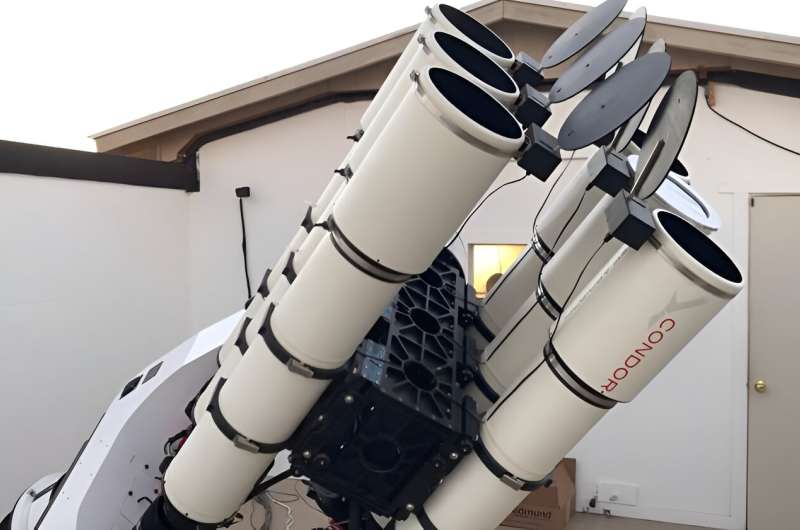A new telescope called the “Condor Array Telescope” may open up a new world of the very-low-brightness universe for astrophysicists. Four new papers, published back to back in the Monthly Notices of the Royal Astronomical Society (MNRAS) this month, present the first scientific findings based on observations acquired by Condor. The project is a collaborative led by scientists in the Department of Physics and Astronomy at Stony Brook University and the American Museum of Natural History (AMNH).
According to lead researchers Kenneth M. Lanzetta, Ph.D., a Professor in the Department of Physics and Astronomy and Stefan Gromoll of Stony Brook, and Michael M. Shara, Ph.D., Curator in the Department of Astrophysics at the AMNH, Condor is now in full operation. The new “array telescope” uses computers to combine light from several smaller telescopes into the equivalent of one larger telescope and is able to detect and study astronomical features that are too faint to be seen with conventional telescopes.
In the first paper, Lanzetta and colleagues used Condor to study extremely faint “stellar streams” surrounding the nearby galaxy NGC 5907, a well-known spiral galaxy located some 50 million light years from Earth.
Such streams are produced when dwarf companion galaxies are disrupted by the tidal gravitational force of the primary galaxy. A previous image obtained by a different telescope in 2010 appeared to show a remarkable stellar stream forming two complete loops of a helix surrounding the galaxy. But another image obtained by the “Dragonfly Telephoto Array” in 2019 showed no trace of this helix.
The Condor team decided to test the new array telescope and to weigh in on the discrepancy. They obtained a deep image of NGC 5907 in 2022. Like the Dragonfly image, the Condor image showed no trace of the helix, leading the team to conclude that the helix of the 2010 image was likely an artifact related to the image processing. The Condor image also revealed faint features that were not picked up by the previous images.
In the second paper, Shara and colleagues used Condor to reassess an image of the dwarf nova Z Camelopardalis or “Z Cam” obtained by the Kitt Peak National Observatory 4-meter telescope back in January 2007. The image showed a partial shell of gas surrounding Z Cam, which Shara speculated was emitted by a “new star” recorded by Chinese Imperial astrologers in the year 77 BCE.
To test this speculation, the Condor team obtained a new image of Z Cam in November 2021. Then by comparing the positions of the shell in the earlier and later images, they measured the expansion rate of the shell, finding a rate that is indeed consistent with an explosion more than 2000 years ago.

But to their astonishment, the team found that the new Condor image revealed the complete shell of gas surrounding Z Cam, rather than the partial shell shown by the 4-meter telescope. Further, the Condor image revealed yet another, larger shell surrounding the first shell.
“These new images demonstrate just how sensitive Condor is. The new shells are simply too faint to be seen by conventional telescopes,” says Lanzetta.
“This is the first example ever found of two concentric shells surrounding a dwarf nova, and it confirms a long-standing hypothesis that concentric shells must surround frequently erupting novae of relatively massive white dwarfs,” says Shara, lead author of the Z Cam paper.
Two other papers describe another extremely faint shell of gas surrounding another nova. That shell was predicted to exist but was too faint for conventional telescopes to detect. It is 50 times larger than previously known nova shells and is the product of multiple nova shells crashing into each other over tens of thousands of years.
Lanzetta’s past research has centered on extragalactic astronomy and cosmology, including issues of galaxy formation and evolution of the intergalactic medium. Gromoll is an expert on large-scale scientific computing. Shara’s past research has centered on novae and the late stages of stellar evolution.
Lanzetta and Gromoll began working on Condor in 2019. Shara joined the project in 2020. In 2021, the Condor team deployed the instrument to a very dark astronomical site at the Dark Sky New Mexico observatory in the southwest corner of New Mexico, near the town of Animas.
More information:
Kenneth M Lanzetta et al, Introducing the Condor array telescope II – deep imaging observations of the edge-on spiral galaxy NGC 5907 and the NGC 5866 Group: yet another view of the iconic stellar stream, Monthly Notices of the Royal Astronomical Society (2024). DOI: 10.1093/mnras/stad3806
Michael M Shara et al, Introducing the Condor Array Telescope – III. The expansion and age of the shell of the dwarf nova Z Camelopardalis, and detection of a second, larger shell, Monthly Notices of the Royal Astronomical Society (2024). DOI: 10.1093/mnras/stad3220
Michael M Shara et al, Introducing the Condor Array Telescope – IV. A possible nova super-remnant surrounding the putative recurrent nova KT Eridani, Monthly Notices of the Royal Astronomical Society (2024). DOI: 10.1093/mnras/stad3612
M W Healy-Kalesh et al, Hydrodynamic simulations of the KT Eridani nova super-remnant, Monthly Notices of the Royal Astronomical Society (2023). DOI: 10.1093/mnras/stad3190
Citation:
Condor telescope reveals a new world for astrophysicists (2024, March 12)
retrieved 12 March 2024
from https://phys.org/news/2024-03-condor-telescope-reveals-world-astrophysicists.html
This document is subject to copyright. Apart from any fair dealing for the purpose of private study or research, no
part may be reproduced without the written permission. The content is provided for information purposes only.

